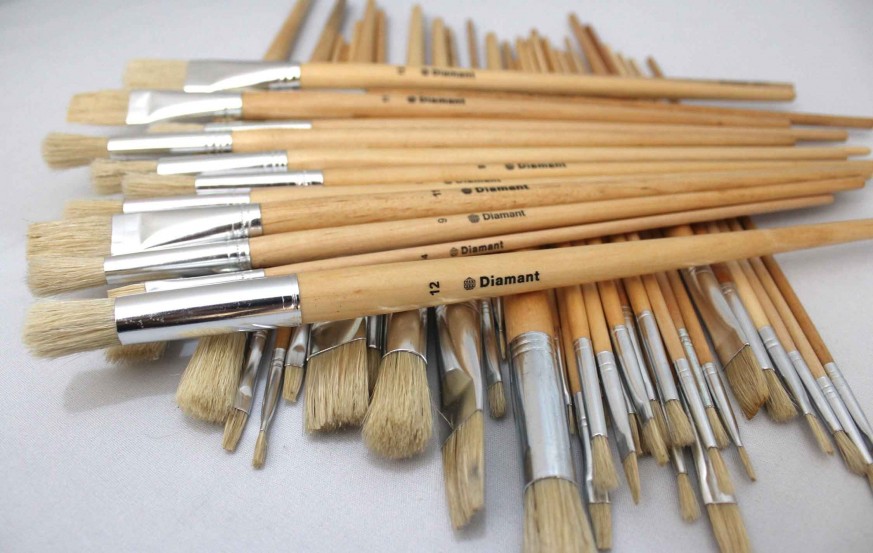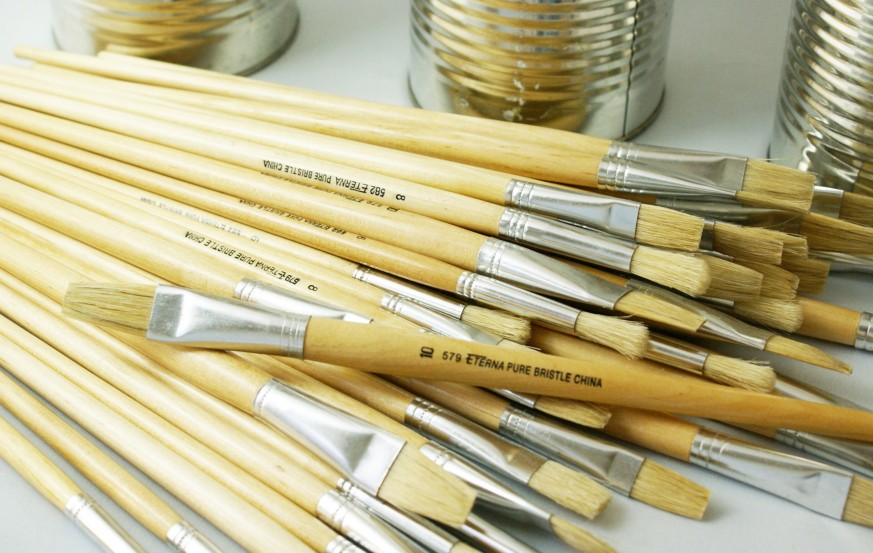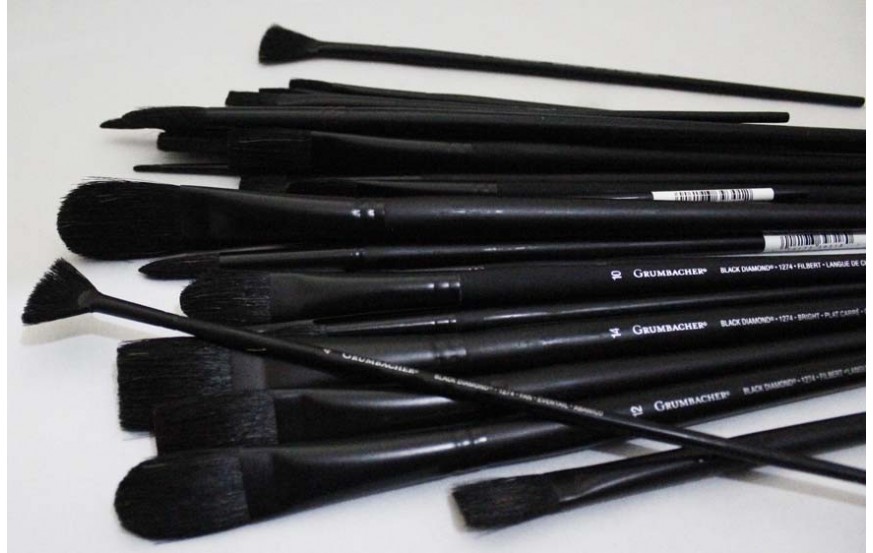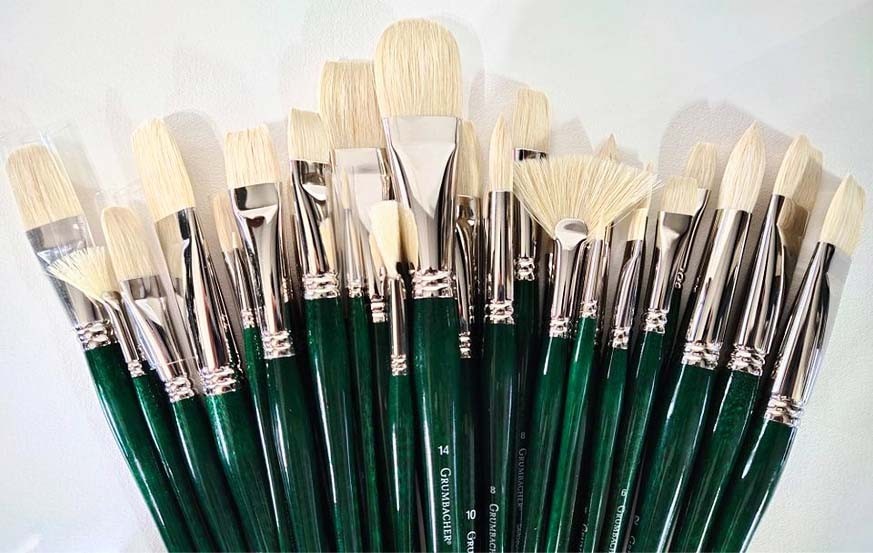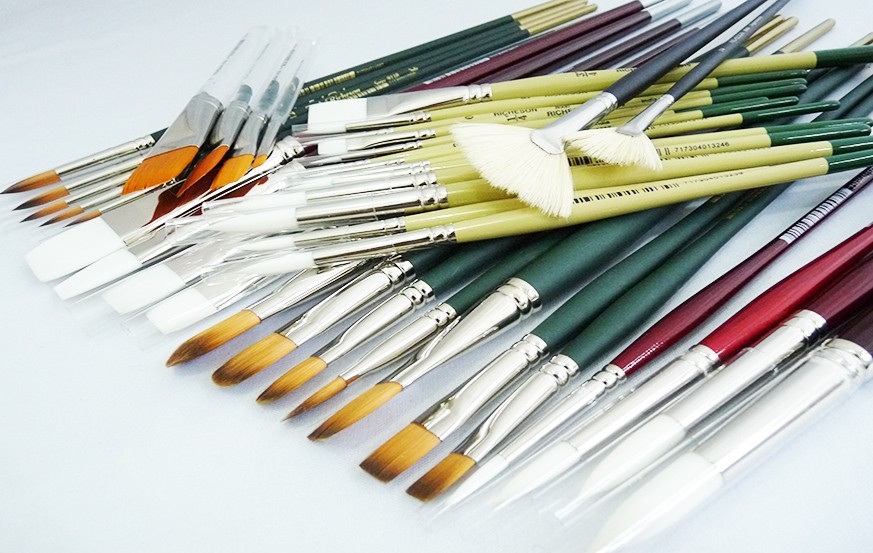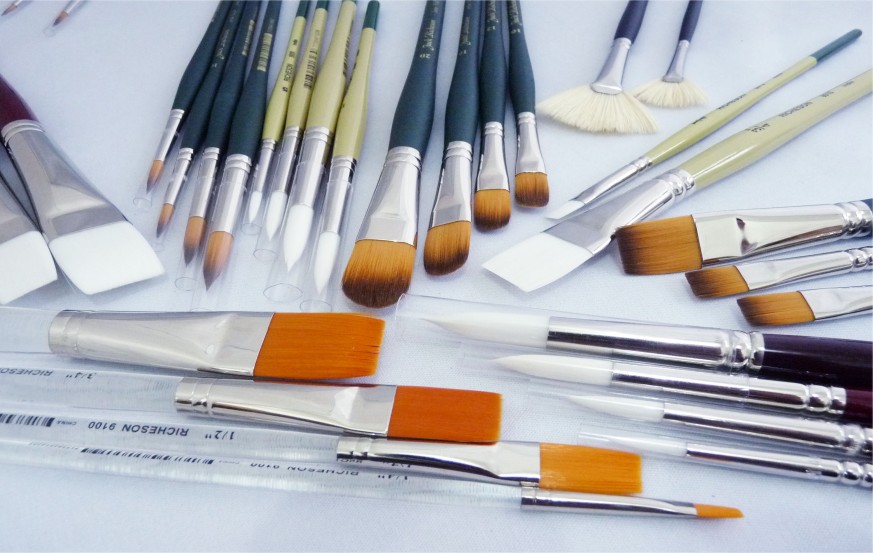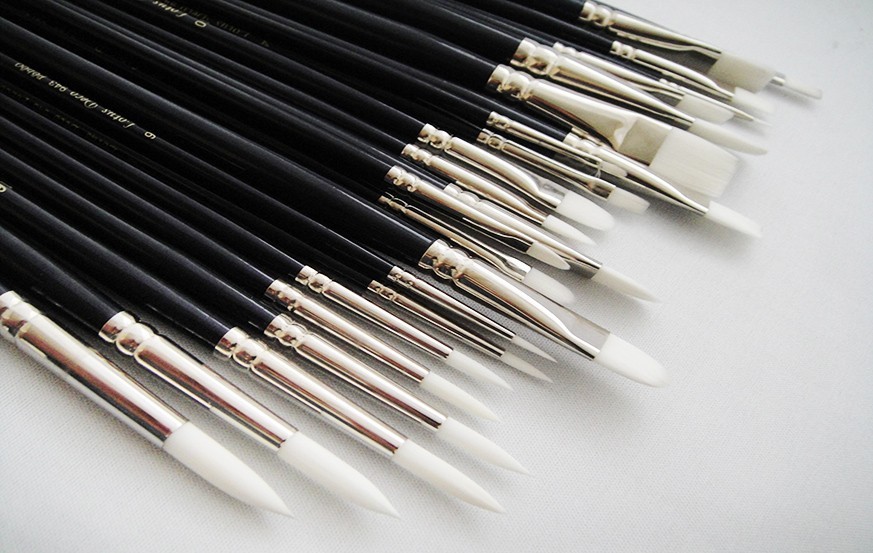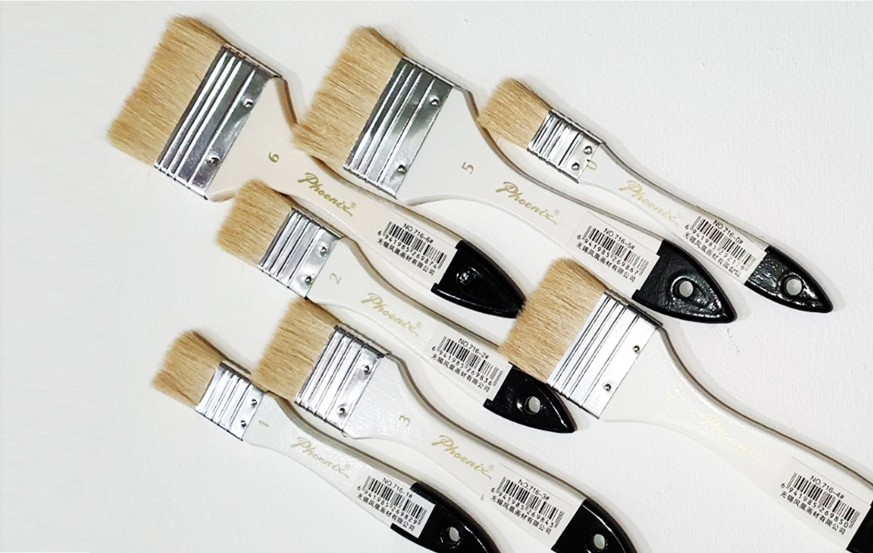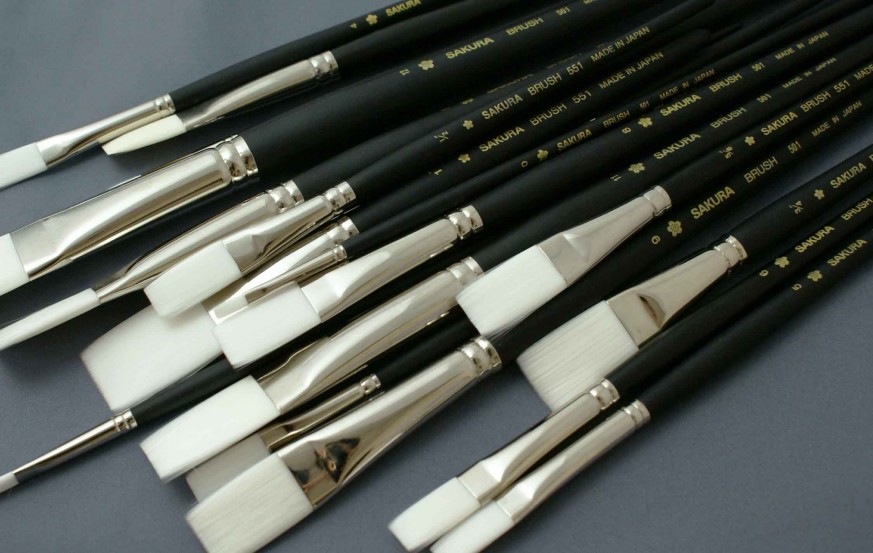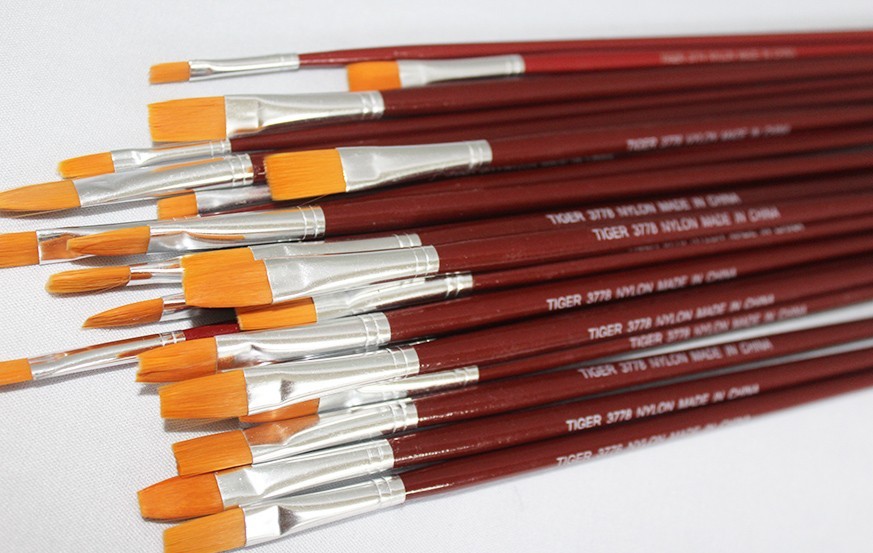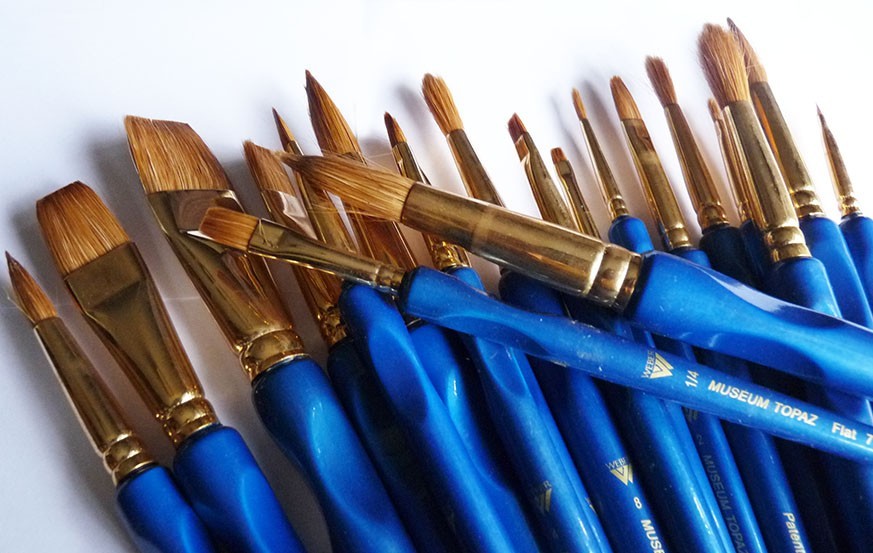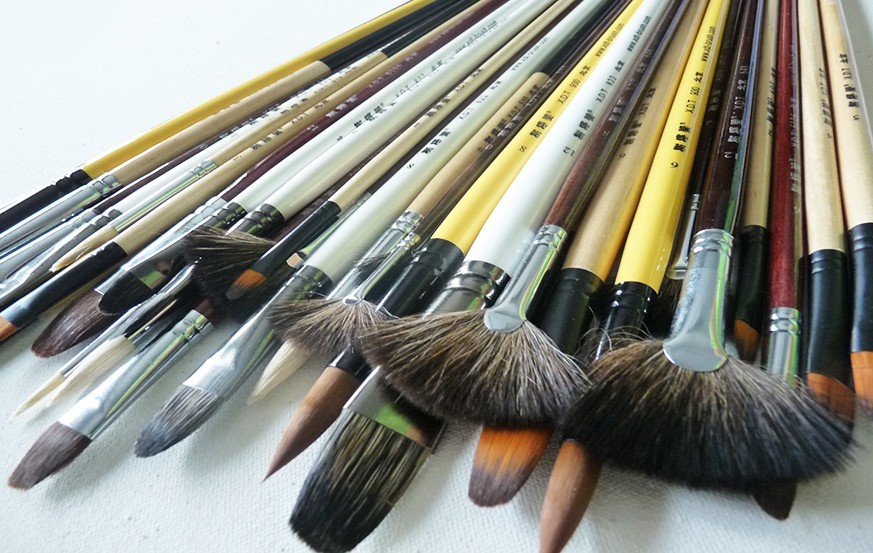Shopping Cart
No products
Prices are tax included
Brush

Paintbrushes are used for applying ink or paint. These brushes are usually made by clamping the bristles to a handle with a ferrule.
Short handled brushes are for watercolor or ink painting while the long handled brushes are for oil or acrylic paint. The styles of brush tip seen most commonly are:
- Round: Long closely arranged bristles for detail
- Flat: For spreading paint quickly and evenly over a surface. They will have longer hairs than their Bright counterpart.
- Bright: Flat brushes with short stiff bristles, good for driving paint into the weave of a canvas in thinner paint applications, as well as thicker painting styles like impasto work.
- Filbert: Flat brushes with domed ends. They allow good coverage and the ability to perform some detail work.
- Fan: For blending broad areas of paint.
- Angle: Like the Filbert, these are versatile and can be applied in both general painting application as well as some detail work.
- Mop: A larger format brush with a rounded edge for broad soft paint application as well as for getting thinner glazes over existing drying layers of paint without damaging lower layers.
- Rigger: Round brushes with longish hairs, traditionally used for painting the rigging in pictures of ships. They are useful for fine lines and are versatile for both oils and watercolors.
THE STRUCTURE OF AN ARTIST PAINT BRUSH
The artist paint brushes used for oil painting consist of the ferrule, the handle and the bristles. The ideal material for the handle is a hardwood from one of the deciduous species of tree. A particularly suitable type of wood is beech, which has a very low water uptake. This means that the wood keeps its shape, and a good connection between the handle and the ferrule can be maintained.
The ferrule on a high-quality brush must be free of welds or joints, made of copper or brass and fit snugly around the handle, so that there are no air-pockets between the two. The bristles are the working part of the brush and, it’s fair to say, the most important part, for it is based on the bristles that an artist selects the right brush for any given painting. They may be made of natural materials or synthetic fibres, and they come in various shapes and sizes.
HOW TO CHOOSE A BRUSH DEPENDING ON THE MATERIAL
Brushes made with natural bristles
These are the most common brushes and the ones most often used by artists. They are made of hog’s hair and are considered to be among the best kinds of brush for oil painting. Natural bristles pick up the paint very well and apply the load to the canvas well. Making a brush with natural bristles is a fairly complicated procedure. The bristles are boiled and bleached and then any split ends are removed.
Kolinsky sable-hair brushes
A kolinsky is a small carnivorous animal, similar to a ferret. These brushes, like those made of hog’s hair, are natural paintbrushes and are commonly used to create watercolours and oil paintings. Sable-hair brushes are usually used by artists who like to paint in thin, translucent layers. Sable-hair brushes provide soft, subtle strokes, making them ideally suited for portrait-painting and for all the fine detail in a painting. Artist brushes made of sable-hair will last a long time, if you use a fine-grained canvas. When using a medium-grained canvas, meanwhile, you’ll find you can wipe off any stray bristles from the brush more quickly. Natural sable-hair brushes are also suitable for the ‘drybrush’ painting technique.
Synthetic brushes
One hears various things said about synthetic brushes for oil painting, and the feedback about them is mixed. With the emergence of good-quality brushes made with synthetic fibres, however, novice painters are increasingly shunning brushes with natural bristles. Good synthetic brushes can sometimes be on a par with natural brushes. Synthetic brushes are now available with varying degrees of bristle thickness, enabling artists to choose their brush depending on the task at hand. Thick synthetic bristles are suitable for doing the undercoat and for the fast alla prima painting technique (as are brushes made of natural bristles). Thin synthetic bristles, on the other hand, are similar to natural sable-hair brushes. They can be used to paint paintings consisting of lots of thin layers. By comparison with brushes made of hog’s hair and sable-hair, synthetic brushes have both upsides and downsides. The bristles don’t fall out of them. They are easier to look after (thinning agents, diluents and linseed oil all affect natural brushes in different ways). They last longer and are suitable for any canvas, however finely or coarsely grained. Some brushes made with synthetic fibres may lose their shape over time and become bushy. There are loads of suggestions to be found on the Internet, though, about how to solve this problem and get the brush back to its original shape.
Squirrel-hair brushes
These brushes are not used in oil painting, or at least not widely used. Some artists use these brushes to lend a light tint to the paint. This is purely a matter of personal preference and habit, though. Squirrel-hair brushes are perfect for painting with watercolours, but when used with oil they quickly become unfit for use. Paintbrushes are among the most important tools of all in an artist’s hands. But an even more important factor is whether the artist knows how to use them and look after them.
Paintbrushes are used for applying ink or paint. These brushes are usually made by clamping the bristles to a handle with a ferrule.
Short handled brushes are for watercolor or ink painting while the long handled brushes are for oil or acrylic paint. The styles of brush tip seen most commonly are:
- Round: Long closely arranged bristles for detail
- Flat: For spreading paint quickly and evenly over a surface. They will have longer hairs than their Bright counterpart.
- Bright: Flat brushes with short stiff bristles, good for driving paint into the weave of a canvas in thinner paint applications, as well as thicker painting styles like impasto work.
- Filbert: Flat brushes with domed ends. They allow good coverage and the ability to perform some detail work.
- Fan: For blending broad areas of paint.
- Angle: Like the Filbert, these are versatile and can be applied in both general painting application as well as some detail work.
- Mop: A larger format brush with a rounded edge for broad soft paint application as well as for getting thinner glazes over existing drying layers of paint without damaging lower layers.
- Rigger: Round brushes with longish hairs, traditionally used for painting the rigging in pictures of ships. They are useful for fine lines and are versatile for both oils and watercolors.
THE STRUCTURE OF AN ARTIST PAINT BRUSH
The artist paint brushes used for oil painting consist of the ferrule, the handle and the bristles. The ideal material for the handle is a hardwood from one of the deciduous species of tree. A particularly suitable type of wood is beech, which has a very low water uptake. This means that the wood keeps its shape, and a good connection between the handle and the ferrule can be maintained.
The ferrule on a high-quality brush must be free of welds or joints, made of copper or brass and fit snugly around the handle, so that there are no air-pockets between the two. The bristles are the working part of the brush and, it’s fair to say, the most important part, for it is based on the bristles that an artist selects the right brush for any given painting. They may be made of natural materials or synthetic fibres, and they come in various shapes and sizes.
HOW TO CHOOSE A BRUSH DEPENDING ON THE MATERIAL
Brushes made with natural bristles
These are the most common brushes and the ones most often used by artists. They are made of hog’s hair and are considered to be among the best kinds of brush for oil painting. Natural bristles pick up the paint very well and apply the load to the canvas well. Making a brush with natural bristles is a fairly complicated procedure. The bristles are boiled and bleached and then any split ends are removed.
Kolinsky sable-hair brushes
A kolinsky is a small carnivorous animal, similar to a ferret. These brushes, like those made of hog’s hair, are natural paintbrushes and are commonly used to create watercolours and oil paintings. Sable-hair brushes are usually used by artists who like to paint in thin, translucent layers. Sable-hair brushes provide soft, subtle strokes, making them ideally suited for portrait-painting and for all the fine detail in a painting. Artist brushes made of sable-hair will last a long time, if you use a fine-grained canvas. When using a medium-grained canvas, meanwhile, you’ll find you can wipe off any stray bristles from the brush more quickly. Natural sable-hair brushes are also suitable for the ‘drybrush’ painting technique.
Synthetic brushes
One hears various things said about synthetic brushes for oil painting, and the feedback about them is mixed. With the emergence of good-quality brushes made with synthetic fibres, however, novice painters are increasingly shunning brushes with natural bristles. Good synthetic brushes can sometimes be on a par with natural brushes. Synthetic brushes are now available with varying degrees of bristle thickness, enabling artists to choose their brush depending on the task at hand. Thick synthetic bristles are suitable for doing the undercoat and for the fast alla prima painting technique (as are brushes made of natural bristles). Thin synthetic bristles, on the other hand, are similar to natural sable-hair brushes. They can be used to paint paintings consisting of lots of thin layers. By comparison with brushes made of hog’s hair and sable-hair, synthetic brushes have both upsides and downsides. The bristles don’t fall out of them. They are easier to look after (thinning agents, diluents and linseed oil all affect natural brushes in different ways). They last longer and are suitable for any canvas, however finely or coarsely grained. Some brushes made with synthetic fibres may lose their shape over time and become bushy. There are loads of suggestions to be found on the Internet, though, about how to solve this problem and get the brush back to its original shape.
Squirrel-hair brushes
These brushes are not used in oil painting, or at least not widely used. Some artists use these brushes to lend a light tint to the paint. This is purely a matter of personal preference and habit, though. Squirrel-hair brushes are perfect for painting with watercolours, but when used with oil they quickly become unfit for use. Paintbrushes are among the most important tools of all in an artist’s hands. But an even more important factor is whether the artist knows how to use them and look after them.
Subcategories
Baohong Flat Brush
Diamant Brush
NOTE: ONLY AVAILABLE ONLINE
To check availability in store branches, please CALL
*Bamboo Bristle Brush
*For Arcylic and Oil
Eterna Brush
Grumbacher Black Diamond Brush


Grumbacher Gainsborough Brush
Jack Richeson Extreme Kolinsky Brush
The first known use of the name Kolinsky was around 1851. The term refers to several varieties of Asian Weasels. Most typically referenced is the Marten weasel. The yellowish brown tail from the weasel is used to make high grade artist brushes. The finest Kolinsky hair comes from the Kolin Peninsula and then from a very high ratio of male hair to female hair. The female lives in an underground burrow and is rarely outside. The male is the hunter and forager. He hunts to bring food back to the family. Because he is outdoors most of the time, his coat is rich and thick and long. Their natural diet is one reason why farming these weasels has never been very successful.
The Series 7777 Extreme Kolinsky Round Brushes are produced by Richeson Art and are famous for their amazing quality and point and snap. These brushes are made by skilled German artisans and feature fine high quality brush hair. The brushes release paint evenly while holding paint in very well, and they are perfect for many different types of watercolor art works. Each brush is crafted with a high ratio of male Asian weasel hair, which is the best quality hair for high grade artist brushes. Richeson has sought to produce the finest watercolor brushes that are available anywhere, and this round brush set is made with that commitment. They are sure to meet any artist’s expectations for quality and functionality.
These Richeson Series 7778 Extreme Kolinsky Flat Brushes are an essential tool for any serious watercolor artist. They are produced by Richeson Art, a world renowned brush producer, and these are some of the finest watercolor brushes available anywhere. The Kolinsky hair comes from a variety of different Asian weasels, and the tail from the weasel is used to make these brushes. They are excellent in quality and hold color in very well, and the brush hairs are designed to last for several years when properly maintained. Professional grade brushes that can fit well into any artist’s tool set, and created by skilled artisans for the best quality possible.
Jack Richeson Oil & Acrylic Brush
Famous for their lasting qualities, easy care and affordable price, our synthetic oil & acrylic line of brushes offers a great seelction for any artist. Made with the lastest hi-tech fiber, these brushes are available in three textures to compliment different painting styles.
Kulay Art Materials Artist Brush
A Good quality brush made of synthetic nylon, kolinsky, soft bristle use for all medium.
Maries Martol Brush
NOTE: ONLY AVAILABLE ONLINE
To check availability in store branches, please CALL
Marie's fine flat head bristle hair painting brushes for oil, gouache, acrylic painting.
Maries Shapes Nylon Paint Brush Wooden Handle Gouache Watercolor Oil Painting brush drawing
Old Holland Brush
Old Holland Chungking Bristle Professional Brushes are specially constructed to the exacting specifications of the world’s premier paint manufacturer these classic quality bristle brushes not only look beautiful but perform to the highest standard as you would expect from a brush bearing the Old Holland name. Each brush is handmade using only the finest Chungking bristle, interlocked for shape retention and flagged for superior paint carrying capacity. Mounted on perfectly balanced lacquered burgundy hardwood handles with gold tone seamless ferrules these brushes are the perfect match for Old Holland and other premium quality oils and acrylics.
Perfect For:
- Oil and acrylic paint
- Shape retention
- Classrooms and workshops
- Artists of all levels
Pebeo and Deco Lotus Brush
NOTE: ONLY AVAILABLE ONLINE
To check availability in store branches, please CALL
These top quality brushes from Pebeo are specifically designed for painting onto fabric, glass, porcelain and wood. Square/flat ended synthetic - look after them and they will last for ages.
Lotus brushes are springy, hard wearing, easy to clean, and have good colour retention.White polyamide synthetic bristles; stainless steel ferule; long, blue lacquered handle.Pébéo lotus brushes are ideal for painting with thinned oil paints and acrylics.Pébéo Lotus Round brushes are available in 10 different diameters from 18 to 73mm.The brush heads are available in round, bright and filbert shapes.
Tiger TOP Brush
Tiger Top Brush is a affordable type of nylon brush that can be use in any medium in painting.
ideal for thin paint which spreads easily, such as watercolor paint, and for detailed work as they can form a sharp point which allows for precision painting.
Nylon Brush filled industrial brushes are suitable for a range of applications from aggressive scrubbing to dusting, in both dry and wet environments.
Weber Museum Topaz Brush

The Museum® Blue Topaz Artist Brushes deliver the quality and reliability of high-end natural hair brushes without the high price tag! Choose from sable blend, raccoon, or hog bristle each is specially designed to withstand years of use without losing snap or shape. We pair only the finest materials with the highest quality workmanship to create this premium line that is perfect for all creative techniques in oil, acrylic, watercolor and more.
Weber Professional Permalba Bristle & Pure Red Sable Brush
With innovative materials comes an innovative tool-that’s why artists can trust Permalba® Artists Brushes. This professional series of oil and acrylic brushes continues the tradition of quality and reliability that has become synonymous with the Permalba name. Striking in appearance, this line boasts elongated handles with a silky iridescent pearl finish and seamless nickel-plated brass ferrules to secure interlocked bristles of pure red sable or premium white hog. Professional Permalba® Artists Brushes will deliver the artist the ultimate in precision, control and consistency for years! Available individually.
Winsor & Newton Foundation Brush
NOTE: ONLY AVAILABLE ONLINE
To check availability in store branches, please CALL
Winsor & Newton Foundation Brushes offer value for money brushes, in a variety of shapes and sizes.
Choose your brush set depending on the fluidity of the colour you are using. The brushes are available in packs according to three hair types; hog bristle, white synthetic and golden synthetic. Each pack contains mixed brush heads.
XDT Quality Brush
Badger Hair. For blending oil paint on canvas, Badger Hair is an age-old tradtion. It comes from various parts of the world and is more readily available than most animal hair, although the quality varies greatly. Badger hair is thickest at the point, and relatively thin at the root, so it has a distinctive "bushy" appearance.
Kevrin/Mongoose Hair is strong, resilient, and makes a good long-wearing, medium to professional quality brush for oil and acrylic painting.
Kolinsky Sable is not really from a sable at all, but comes from the tail of a species of mink that is a member of the weasel family found in Siberia and northeastern China. It is generally conceded to be the best material for oil and watercolor brushes due to its strength, spring and ability to retain its shape ("snap"). It holds a very fine point or edge. This is considered a professional grade of hair, and if properly cared for, Kolinsky will last for many years.
Red Sable is obtained from any member of the weasel family with "red" hair, not at all from the animal known as the sable. It is found in a variety of brush styles for many varied mediums, with quality and characteristics varying greatly. A good quality pure Red Sable is a good alternative to the more expensive Kolinsky, with similar performance and durability. Often, weasel hair is blended with ox hair to make a more economical brush, but the fine point is sacrificed.
Synthetics are man-made of either nylon or polyester filaments. They can be tapered, tipped, flagged, abraded or etched to increase color carrying ability. Often, synthetic filaments are dyed and baked to make them softer and more absorbent. The common name for this filament is "Taklon". Advantages of synthetic brushes are: 1) They are less prone to damage from solvents, insects or paints. 2) They are easier to keep clean than animal hair brushes because the filaments don't have animal scale structures to trap paint. 3) They are less prone to breakage and are durable on many different surfaces. 4) They are better suited for painting with acrylics because a synthetic filament will withstand the caustic nature of acrylic paints with less damage.
Gray Squirrel (Talayoutky), most highly in demand for lettering brushes and quills, is native to Russia and nearly always fell in short supply. Brown squirrel (Kazan) is more readily available, and is used mainly for medium quality and scholastic watercolor brushes. A very fine, thin hair, taken from squirrel tails, it points as well as Kolinsky, but has very little "snap" because the hair is not very resilient. It works best with liquid paints and inks.





















